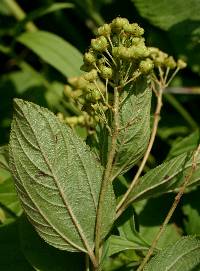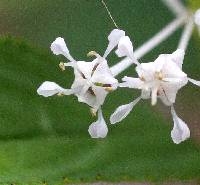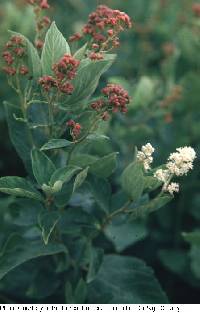|
|
|
|
Family: Rhamnaceae
New Jersey tea
[Ceanothus americanus var. intermedius (Pursh) Torr. & A.Gray, moreCeanothus americanus var. pitcheri Torr. & A. Gray, Ceanothus intermedius Pursh] |
Shrub to 1 m tall, to 1.5 m wide Leaves: alternate, stalked, dark green above, gray beneath, 3 - 8 cm long, 2 - 6 cm wide, broad egg-shaped to oval with a heart-shaped to rounded base and a pointed tip, finely toothed, hairy above, velvety beneath (sometimes only on veins), with three major veins radiating from base. Inflorescence: loosely branched (panicle), borne in a leaf axil on a stalk 5 - 20 cm long, short-cylindric to egg-shaped, 3 - 10 cm long. Flowers: white, tiny, fragrant, with five clawed petals resembing tiny ladels and five stamens. Fruit: a dry, black, berry-like capsule, 5 - 6 mm long, round to triangular, three-parted, with three reddish brown nutlets. Twigs: flexible, dark grayish green to brown, covered with dense hairs. Buds: egg-shaped and pointed. Form: compact with dense upright branches. Similar species: The similar Ceanothus herbaceus has mostly narrow oblong to elliptic leaves, and the inflorescences arise at the tips of the stems. Flowering: June, with sporadic flowering throughout summer Habitat and ecology: Black oak savannas, mesic and dry prairies, and mixed deciduous forests of the dune region. The species forms a large crown and mass of woody roots which help it survive degradation. Occurence in the Chicago region: native Notes: Ceanothus americanus is grown as an ornamental and has a symbiotic relationship with a nitrogen-fixing bacteria. Insects are attracted by the flowers, deer eat the leaves, and birds eat the fruit. Native Americans once made the leaves into a tea and used the large woody roots as fuel on bison hunts and when firewood was scarce. Colonists used the leaves as a substitute for black tea after the Boston Tea Party to support patriotism during the American Revolution. Etymology: Ceanothus comes from an ancient Greek name for a different plant. Americanus means "from North America." Author: The Morton Arboretum Shrub to 1 m, often freely branched; lvs narrowly to broadly ovate, 3-8 cm, usually more than half as wide, obtuse or acute, broadly cuneate to rounded or subcordate at base, the lateral nerves often naked for 1-3 mm at base; infls on axillary peduncles, the lower peduncles progressively longer and to 2 dm, each panicle short-cylindric to ovoid, occasionally branched, often subtended by 1-3 reduced lvs, the individual umbels of the panicle usually separated by distinct internodes; fr depressed-obovoid, 5-6 mm; 2n=24. Upland woods, prairies, and barrens; Que. to Minn., s. to Fla. and Tex. June, July. Var. americanus, occurring mostly in and e. of the mts., has the leaves sparsely pilose only along the nerves beneath. Var. pitcheri Torr. & A. Gray, occurring w. of the mts., has the lvs pubescent across the surface beneath. Var. intermedius Torr. & A. Gray, occurring on the coastal plain from Va. s., differs from var. americanus in its very much branched habit, more numerous infls, and small lvs commonly 2-4 cm. Gleason, Henry A. & Cronquist, Arthur J. 1991. Manual of vascular plants of northeastern United States and adjacent Canada. lxxv + 910 pp. ©The New York Botanical Garden. All rights reserved. Used by permission. |






